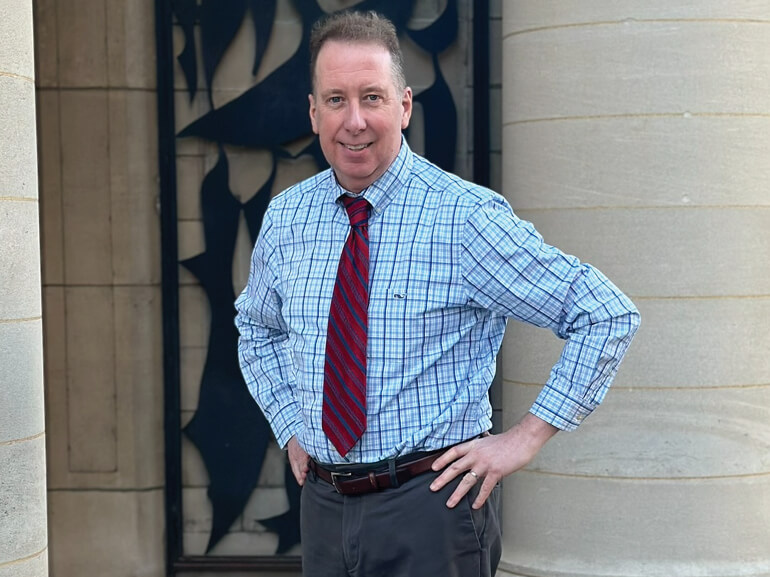Matthew's story

Attorney Matthew Eddy, 56, started to shave one morning before work when he began to feel dizzy and noticed weakness in his right hand. After stumbling out of the bathroom and sitting down on the bed, Matt became disoriented. He was unable to speak. His wife Jill quickly helped him to the car and the two rushed to the emergency room at SSM Health St. Clare Hospital – Fenton.
There, the St. Louis native and father of three underwent two CT scans and an MRI. The following day, a second MRI of Matt’s brain showed the blood clot on the left side of his brain that caused his stroke. Matt’s stroke left him with right-sided weakness, particularly in his right arm. His neurologist recommended he pursue an intensive inpatient rehabilitation program to help him reach his goals of regaining function and getting back to his life.
Three days after his stroke, Matt arrived at SSM Health Rehabilitation Hospital – Bridgeton. He was using a walker to support himself for walking and transfers and was unable to use his right arm during self-care activities including bathing and dressing. Matt’s grip strength in his right hand was drastically reduced to just six-and-a-half pounds. By comparison, the average grip strength for a man Matt’s age ranges from 74 to 127 pounds.
Matt’s interdisciplinary physician-led care team devised a care plan to help him regain his lost strength and independence. He was also looking forward to returning to work and to his status as an “evolving” golfer.
In physical therapy, Matt and his therapists concentrated on dynamic balance activities and normalizing the mechanics of his walking. “Matt made the most out of every minute of therapy,” his physical therapist noted, adding, “He would even tell me about how he would work on his home exercise programs in the early hours of the morning when he couldn't sleep.”
During the course of his 14-day stay at SSM Health Rehabilitation Hospital – Bridgeton, Matt went from using a walker, to a cane and to finally walking a few hundred feet without any device at all. “Matt is one of the hardest working and most motivated patients I've ever had the privilege of working with,” said his therapist. “I'm so proud of him for how far he has come.”
Because Matt was so focused on regaining normal function in his right hand and arm, occupational therapists ensured that his sessions included electrical stimulation, or e-stim, which sends mild electrical pulses through the skin to help stimulate injured muscles or manipulate nerves. By causing repeated muscle contractions, blood flow improves, helping repair and strengthen injured muscles through repeated cycles of contraction and relaxation. Over time, e-stim can “train” muscles to respond to the body’s natural signals to contract, which is especially helpful for those recovering from a stroke. “The e-stim was incredibly helpful because I could still see my right hand rising and flexing and working again,” Matt recalled.
Much like in physical therapy, Matt’s occupational therapy team was impressed by his motivation and work ethic. “Matt wanted to make the most of his time while in rehab. He was always asking for things that he could work on during his time not in therapy,” his occupational therapist said. “He made tremendous progress and will continue to make progress in his next steps.” By the time Matt was ready to be discharged, his grip strength had increased to 30 pounds and he was able to incorporate the use of his arm while bathing and dressing.
Matt said that the main turning points in his rehabilitation experience included when he was able to walk without any assistance and when his fingers started moving again. “I realized that the smallest progress is still a victory,” Matt said. “I looked forward to therapy every day.”
He gave credit to his family, friends and co-workers for their support, giving special kudos to Jill, who helped supervise his showers and went through family training so that she was well equipped to help Matt return home safely. Matt said that a motivating factor throughout his experience is “to give my kids a life lesson by showing them how to get back up after being knocked down. Stay positive and don’t look in the rearview mirror. It’s all about moving forward.”
Describing his recovery as “like running a very long marathon with some breaks," Matt said, adding, “I would do something every day to get me closer to the finish line and that’s what the therapists helped me accomplish.”
During his recovery journey, Matt most looked forward to seeing his family and friends and returning to work and his daily routine. He continued his rehabilitation at the SSM Health Day Institute in Kirkwood over the next eight weeks.
When asked to provide insight to others going through a challenging recovery, Matt offered the following: “Even though there are uncertainties, trust the process, keep a positive attitude, deal with it, rely on the doctors to explain the big picture, and put your recovery in the hands of the therapists. Give 100 percent. Put everything aside and allow therapy to become your job. Rest is just as important as the therapy so you have the energy to give it all you got.”
Less than six months after his stroke, Matt is back to work full-time as a litigator, and has planned a golf trip to South Florida in hopes of fixing his slice